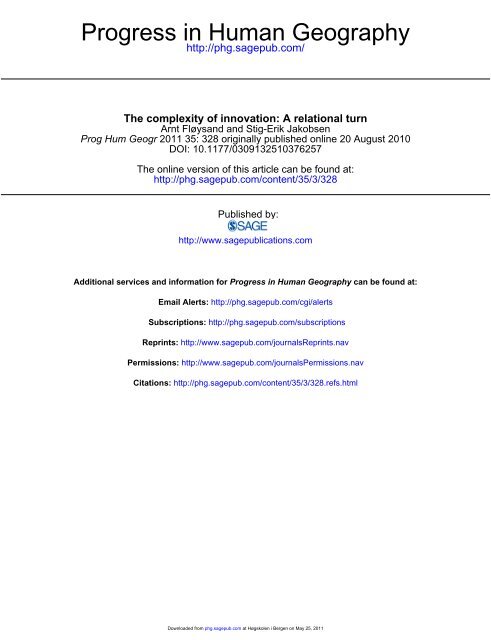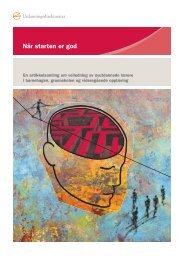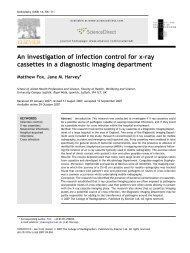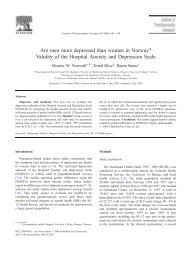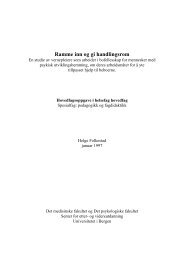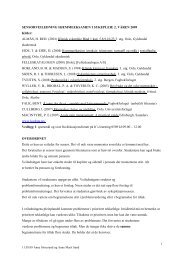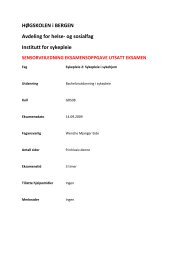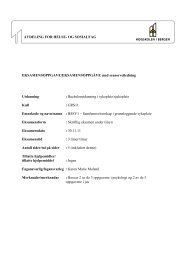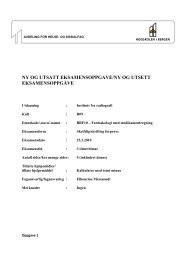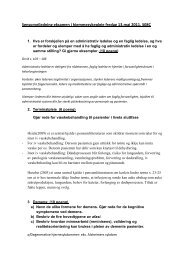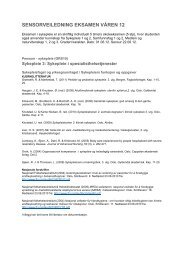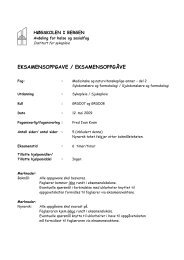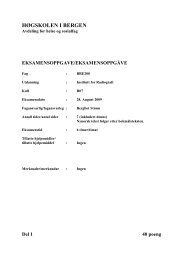Progress in Human Geography - Høgskolen i Bergen
Progress in Human Geography - Høgskolen i Bergen
Progress in Human Geography - Høgskolen i Bergen
- No tags were found...
Create successful ePaper yourself
Turn your PDF publications into a flip-book with our unique Google optimized e-Paper software.
<strong>Progress</strong> <strong>in</strong> <strong>Human</strong> <strong>Geography</strong>http://phg.sagepub.com/The complexity of <strong>in</strong>novation: A relational turnArnt Fløysand and Stig-Erik JakobsenProg Hum Geogr 2011 35: 328 orig<strong>in</strong>ally published onl<strong>in</strong>e 20 August 2010DOI: 10.1177/0309132510376257The onl<strong>in</strong>e version of this article can be found at:http://phg.sagepub.com/content/35/3/328Published by:http://www.sagepublications.comAdditional services and <strong>in</strong>formation for <strong>Progress</strong> <strong>in</strong> <strong>Human</strong> <strong>Geography</strong> can be found at:Email Alerts: http://phg.sagepub.com/cgi/alertsSubscriptions: http://phg.sagepub.com/subscriptionsRepr<strong>in</strong>ts: http://www.sagepub.com/journalsRepr<strong>in</strong>ts.navPermissions: http://www.sagepub.com/journalsPermissions.navCitations: http://phg.sagepub.com/content/35/3/328.refs.htmlDownloaded from phg.sagepub.com at Høgskolen i <strong>Bergen</strong> on May 25, 2011
ArticleThe complexity of <strong>in</strong>novation:A relational turn<strong>Progress</strong> <strong>in</strong> <strong>Human</strong> <strong>Geography</strong>35(3) 328–344ª The Author(s) 2010Repr<strong>in</strong>ts and permission:sagepub.co.uk/journalsPermissions.nav10.1177/0309132510376257phg.sagepub.comArnt FløysandUniversity of <strong>Bergen</strong>, NorwayStig-Erik JakobsenUniversity of Oslo, NorwayAbstractRecent contributions with<strong>in</strong> the system of <strong>in</strong>novation approach are marked by an <strong>in</strong>strumentalism that views<strong>in</strong>novation as a predictable and standardized process that <strong>in</strong> most aspects counters theories and empiricalobservations stress<strong>in</strong>g the multilevel, spontaneous and complex features of <strong>in</strong>novation. Informed by therelational turn with<strong>in</strong> economic geography this paper develops an alternative analytical framework. Wedo this stepwise: first, by elaborat<strong>in</strong>g on how <strong>in</strong>novation was orig<strong>in</strong>ally def<strong>in</strong>ed with<strong>in</strong> the systems of<strong>in</strong>novation approach; second, by outl<strong>in</strong><strong>in</strong>g a relational based analytical framework based on the concept ofsocial fields; and, f<strong>in</strong>ally, by demonstrat<strong>in</strong>g how it has been applied.Keywords<strong>in</strong>formal knowledge, <strong>in</strong>novations, relational turn, rules of conduct, social fieldsI IntroductionLiberalization of trade and f<strong>in</strong>ancial markets,together with technological advances (particularly<strong>in</strong> <strong>in</strong>formation and communications technology)have reduced geographical and otherbarriers previously protect<strong>in</strong>g domestic <strong>in</strong>dustriesaga<strong>in</strong>st <strong>in</strong>ternational trade competition. Firmsmust cont<strong>in</strong>ually <strong>in</strong>novate to compete beyondregional borders <strong>in</strong> this new global reality. Thedevelopment of new knowledge, new ways ofdo<strong>in</strong>g th<strong>in</strong>gs and new products have been portrayedas the key factors <strong>in</strong> improv<strong>in</strong>g globalcompetitiveness for bus<strong>in</strong>ess sectors, places andregions.Several approaches, based on studies thatrange from apply<strong>in</strong>g the evolutionary ideas ofSchumpeter (Fagerberg, 2003) to recent contributionsbuild<strong>in</strong>g on ideas of complexity th<strong>in</strong>k<strong>in</strong>g(Fonseca, 2002; Mart<strong>in</strong> and Sunley, 2007), havebeen developed to understand why and how<strong>in</strong>novation does (or does not) occur. Much of thewrit<strong>in</strong>g has been on the systems of <strong>in</strong>novationapproach (Cooke, 2001; Edquist, 1997; Lundvall,1992). This approach atta<strong>in</strong>ed a hegemonic positionwith<strong>in</strong> the <strong>in</strong>novation literature dur<strong>in</strong>g the1990s and 2000s. However, it has fostered a<strong>in</strong>strumentalism that views <strong>in</strong>novation as a predictableand standardized process that <strong>in</strong> mostaspects counters theories and empirical observationsstress<strong>in</strong>g the multilevel, spontaneous andcomplex features of <strong>in</strong>novation. Several bestCorrespond<strong>in</strong>g author:Arnt Fløysand, Department of <strong>Geography</strong>, University of<strong>Bergen</strong>, Fossw<strong>in</strong>ckelsgt 6, N-5020 <strong>Bergen</strong>, NorwayEmail: arnt.floysand@geog.uib.no328Downloaded from phg.sagepub.com at Høgskolen i <strong>Bergen</strong> on May 25, 2011
Fløysand and Jakobsen 329<strong>in</strong>novation practice models have been developed,<strong>in</strong>formed by empirical evidence from hot spotswith<strong>in</strong> the economy, mak<strong>in</strong>g them less representativeof <strong>in</strong>novation practice with<strong>in</strong> the newmultidimensional global economy. Strong l<strong>in</strong>kagesbetween policy and research practice alsoseems to favour quick fixes and guidel<strong>in</strong>esanticipat<strong>in</strong>g that <strong>in</strong>novation practice can bereplicated and diffused as bluepr<strong>in</strong>ts regardlessof the empirical context. Therefore, the aimof this paper is to develop an alternative analyticalframework emphasiz<strong>in</strong>g <strong>in</strong>novation as a relationalphenomenon.To th<strong>in</strong>k of <strong>in</strong>novation practice as relational<strong>in</strong>volves focus<strong>in</strong>g on networks of actors, theflow of knowledge and assets with<strong>in</strong> thesenetworks, and the <strong>in</strong>terconnectivity of variousnetworks. It also <strong>in</strong>volves acknowledg<strong>in</strong>g hegemonicpositions of certa<strong>in</strong> actors with<strong>in</strong> thesenetworks. The first publications on the <strong>in</strong>novationsystem approach strongly advocated suchan approach. They argued for an understand<strong>in</strong>gof <strong>in</strong>novation as a dynamic, open and <strong>in</strong>teractiveprocess that focused on learn<strong>in</strong>g and network<strong>in</strong>g(Lundvall, 1992). Ironically, with the developmentof strong l<strong>in</strong>kages between research andpolicy, the approach has been reconstructed as astandardized model for best <strong>in</strong>novation practiceand used <strong>in</strong>strumentally for adjust<strong>in</strong>g system failureswith<strong>in</strong> national, regional and even local <strong>in</strong>novationsystems (see, for <strong>in</strong>stance, Enright, 2003;Ffowcs-Williams, 2004; Sôlvell et al., 2003).Some studies have warned aga<strong>in</strong>st this practicebecause it presupposes the <strong>in</strong>novationprocess to be a phenomenon that can be controlledand guided (Balzat and Hanusch,2004; Lundvall, 2007). Second, it very oftenpresupposes a geographical co-location of acomprehensive bus<strong>in</strong>ess milieu and an advancedknowledge <strong>in</strong>frastructure of universitiesand research <strong>in</strong>stitutions that are essential for<strong>in</strong>novation (Cooke et al., 2004). This presuppositionrules out most rural contexts wherecerta<strong>in</strong>ly <strong>in</strong>novation can also be observed.Third, this practice seems to foster <strong>in</strong>novationpolicies prioritiz<strong>in</strong>g formal ‘know why’ knowledgeabove contextual and <strong>in</strong>formal knowwhat/who/when/where and how knowledge,ignor<strong>in</strong>g the claim that a comb<strong>in</strong>ation of bothtypes of knowledge gives firms a competitiveedge <strong>in</strong> the market (Howells, 2002; Jensenet al., 2007; Lundvall, 1992).We argue that a spatial- and context-sensitiverelational turn is needed to avoid such contradictions.With<strong>in</strong> the relational turn literature <strong>in</strong>economic geography, economic practice is seenas an action with many goals, from meet<strong>in</strong>gmaterial needs and mak<strong>in</strong>g profits, to seek<strong>in</strong>gsymbolic satisfaction, pleasure and power(Am<strong>in</strong> and Thrift, 2007; Yeung, 2005). However,it has not yet fostered a comprehensive andwell-def<strong>in</strong>ed analytical framework that is readyfor application <strong>in</strong> studies of <strong>in</strong>novation (Batheltand Glückler, 2003). As such, it has been accusedof lack<strong>in</strong>g analytical guidel<strong>in</strong>es (Sunley, 2008).We endorse this criticism.The essence of our analytical framework isthe concept of social field, captur<strong>in</strong>g both the<strong>in</strong>terconnectivity and the time-spatial contextof <strong>in</strong>novation practice. Actors of all k<strong>in</strong>ds, economicactors <strong>in</strong>cluded, operate <strong>in</strong> time-spacesystems of more or less <strong>in</strong>terrelated, but observablesocial fields – ie, dense patterns of socialrelations, marked by a particular time-spatialscale and knowledge production that constra<strong>in</strong>sand enables the agency of actors. Some socialfields may be local, while others may cut acrossgeographical boundaries of clusters, regions andnations. Practices <strong>in</strong> such fields are guided byfield-specific knowledge production that concernsboth formal and <strong>in</strong>formal knowledge,rang<strong>in</strong>g from rules of conduct and conventionsto discourses and narratives that may or may notsusta<strong>in</strong> <strong>in</strong>novation practice. In a globalized sett<strong>in</strong>g,actors participate <strong>in</strong> several overlapp<strong>in</strong>gand <strong>in</strong>terl<strong>in</strong>ked social fields of different scales,with different types of actors, knowledge andrules of conduct. This implies that <strong>in</strong>novationpractices are multifield based, but normally withsome sort of field hegemony.Downloaded from phg.sagepub.com at Høgskolen i <strong>Bergen</strong> on May 25, 2011329
330 <strong>Progress</strong> <strong>in</strong> <strong>Human</strong> <strong>Geography</strong> 35(3)The lesson learned from such a relational turnis that <strong>in</strong>novation studies are not a question of atheory restricted to a limited part of reality. Onthe contrary, they are about three differentth<strong>in</strong>gs. First, <strong>in</strong>novation studies represent theoreticalapproaches thought to have a broad scope;therefore, they have to be fairly abstract. Second,they represent an empirical programme <strong>in</strong> divergentspatial environments and timescales. Third,studies of <strong>in</strong>novation start to represent politicalideologies when theories and empirical f<strong>in</strong>d<strong>in</strong>gsare implemented <strong>in</strong> policy strategies.II Go<strong>in</strong>g back to the rootsOur search for a relational understand<strong>in</strong>g of<strong>in</strong>novation echoes earlier arguments of KarlPolanyi, Mark Granovetter, Torste<strong>in</strong> Hägerstrandand Bengt Åke Lundvall. Polanyi (1944) demonstratedthat economic exchange relations wereenmeshed <strong>in</strong> culture. It is obvious that Polanyi’sthree systems of exchange – reciprocal, redistributiveand market exchange – correspond wellwith arguments with<strong>in</strong> the relational turn that economicrelations are based on some k<strong>in</strong>d of sharedknowledge such as rules of conduct, conventionsand discourses. Second, the focus on socialaspects with<strong>in</strong> <strong>in</strong>novation theory is closelyaligned with Granovetter’s (1985) ideas of contextualiz<strong>in</strong>gall (economic) behaviour with<strong>in</strong> systemsof social relations. His <strong>in</strong>tention was toavoid both the undersocialized view of economicaction <strong>in</strong> neoclassical economics and theoversocialized views of classical sociology.Neither Polanyi nor Granovetter paid attentionto how territorial space affected economicaction. An early <strong>in</strong>terest <strong>in</strong> spatial position<strong>in</strong>gof economic action can be l<strong>in</strong>ked to Hägerstrand’stime-geography that dealt with howterritorial time-space expla<strong>in</strong>s action (Hägerstrand,1970). Hägerstrand was concerned tomap the time-spatial dimensions of action bytransform<strong>in</strong>g action <strong>in</strong>to a geometrical form(Hägerstrand, 1970). However, this timegeographywas accused of fail<strong>in</strong>g to <strong>in</strong>tegrate<strong>in</strong>stitutional conditions.Much of the <strong>in</strong>novation literature has beenl<strong>in</strong>ked to the systems of <strong>in</strong>novation approachpioneered especially by Bengt Åke Lundvall(1992). 1 Lundvall argued for an understand<strong>in</strong>gof <strong>in</strong>novation as an open and dynamic processmarked by a certa<strong>in</strong> uncerta<strong>in</strong>ty: ‘<strong>in</strong> practicallyall parts of the economy, and at all times, weexpect to f<strong>in</strong>d ongo<strong>in</strong>g processes of learn<strong>in</strong>g,search<strong>in</strong>g and explor<strong>in</strong>g, which result <strong>in</strong> newproducts, new techniques, new forms of organizationand new markets’ (p. 8). Innovationappears not as a s<strong>in</strong>gle event, but rather as an<strong>in</strong>teractive process, <strong>in</strong>volv<strong>in</strong>g network<strong>in</strong>g,learn<strong>in</strong>g and feedback loops among varioustypes of actors such as firms, research and development<strong>in</strong>stitutions, political authorities, andtra<strong>in</strong><strong>in</strong>g centres. Lundvall also claimed that theprocess of <strong>in</strong>novation is uncerta<strong>in</strong> and disruptive.He stressed how research and <strong>in</strong>novationfrom time to time produces ‘results which wereneither anticipated nor looked for’ (p. 12). Thisview on <strong>in</strong>novation as an <strong>in</strong>teract<strong>in</strong>g processhighlights the complexity of systems of <strong>in</strong>novation.The boundaries of a system of <strong>in</strong>novationcannot be sharply determ<strong>in</strong>ed. The dist<strong>in</strong>ctionsamong local, regional, national and even <strong>in</strong>ternationalsystems of <strong>in</strong>novation will be blurredand overlapp<strong>in</strong>g: ‘a def<strong>in</strong>ition of the system of<strong>in</strong>novation must, to a certa<strong>in</strong> degree, be keptopen and flexible regard<strong>in</strong>g which subsystemsshould be <strong>in</strong>cluded and which processes shouldbe studied’ (p. 13).Regardless of any uncerta<strong>in</strong>ties over theresults of <strong>in</strong>novation processes, some guidel<strong>in</strong>esare arguably relevant to organiz<strong>in</strong>g the <strong>in</strong>novationprocesses <strong>in</strong> firms and creat<strong>in</strong>g a wellfunction<strong>in</strong>g<strong>in</strong>novation system. The literatureon regional <strong>in</strong>novation systems (RIS) exemplifiesthis through models and guidel<strong>in</strong>es (Cooke,2001; Tödtl<strong>in</strong>g and Trippl, 2005). However,implementation of the systems of <strong>in</strong>novationapproach <strong>in</strong> an empirical programme seems tohave altered the orig<strong>in</strong>al def<strong>in</strong>ition of <strong>in</strong>novation330Downloaded from phg.sagepub.com at Høgskolen i <strong>Bergen</strong> on May 25, 2011
Fløysand and Jakobsen 331as a dynamic and complex process marked byuncerta<strong>in</strong>ty, towards an understand<strong>in</strong>g of <strong>in</strong>novationas a predictable and standardized process.Best-practice <strong>in</strong>novation studies have beendeveloped that comb<strong>in</strong>e concepts from the systemsof <strong>in</strong>novation approach and the term<strong>in</strong>ologyof corporate benchmark<strong>in</strong>g and policy-mak<strong>in</strong>g(Balzat and Hanusch, 2004). 2 Benchmark<strong>in</strong>gwith<strong>in</strong> these studies usually follows a two-stepprocedure. First, various <strong>in</strong>dicators for <strong>in</strong>novationand best practices are identified among thesystems that are be<strong>in</strong>g analysed. Second, basedon the results of these studies, policy recommendationsare developed, more or less regardlessof the dissimilarities between the variouscontexts that have been studied (Enright, 2003;Polt et al., 2001; Sölvell et al., 2003). Thesebest-practice studies have also resulted <strong>in</strong> thedevelopment of more standardized <strong>in</strong>dicators for<strong>in</strong>novation. Furman et al. (2002), for example,have developed the concept of national <strong>in</strong>novationcapacity, referr<strong>in</strong>g to a system’s ability toproduce and commercialize new technologies,the strength of the formal <strong>in</strong>novation <strong>in</strong>frastructure(such as research and education), thestrength of the <strong>in</strong>dustry sectors, and l<strong>in</strong>kagesbetween research <strong>in</strong>stitutions and <strong>in</strong>dustry. Thisconcept has been applied by Porter and Stern(2002). Several stage or phase models for <strong>in</strong>novationsystems or clusters have also been developed,whereby a system is anticipated to movefrom one clearly def<strong>in</strong>ed phase to the next,either as a consequence of the dynamics of thesystem, or as a result of facilitation providedby political authorities (Ffowcs-Williams,2004). This development implies that ‘performancecomparisons across systems have graduallymoved towards the centre of attention,while less importance has been given to the considerationof systemic dissimilarities’ (Balzatand Hanusch, 2004: 198). Lundvall (2007) haswarned aga<strong>in</strong>st this development, and stated thatpolicy-makers have <strong>in</strong>terpreted the <strong>in</strong>novationsystem <strong>in</strong> a mechanistic and functionalistic way,with an assumption that such a system can beconstructed, governed and manipulated. Thisis supported by de Bruijn and Lagendijk(2005: 1155) stat<strong>in</strong>g that models for <strong>in</strong>novations,such as RIS, has been transformed <strong>in</strong>to‘a k<strong>in</strong>d of ideal model applicable to all regions,<strong>in</strong>clud<strong>in</strong>g less successful regions’. Uyarra(2010) suggests a need to be cautious aboutreproduc<strong>in</strong>g such ideal models, address<strong>in</strong>g theneed for more context-sensitive models.Treat<strong>in</strong>g Polanyi, Granovetter, Hägerstrandand Lundvall collectively, we argue that thereis a need for an empirical programme that, contraryto best-practice studies with<strong>in</strong> the systemsof <strong>in</strong>novation approach, highlights the <strong>in</strong>terplayof <strong>in</strong>novations with their cultural, social and territorialcontexts. A precondition of thisargument is that <strong>in</strong>novations are unpredictableand that they should be treated as part of a politicallyconstructed and dynamic processenmeshed <strong>in</strong> relational time-spatial contexts. Inrecent studies of <strong>in</strong>novation with<strong>in</strong> relationaleconomic geography, such cultural, social andterritorial aspects have been approached <strong>in</strong> particularthrough a revised understand<strong>in</strong>g of theconcept of embeddedness def<strong>in</strong>ed by Hess(2004) to evolve around territorial, societal andnetwork embeddedness. Different forms ofembeddedness are seen as overlapp<strong>in</strong>g relationalphenomena comb<strong>in</strong><strong>in</strong>g to constitute the spacetimecontext that is constra<strong>in</strong><strong>in</strong>g and enabl<strong>in</strong>geconomic <strong>in</strong>novation. Paraphras<strong>in</strong>g Yeung, whoargues for a time-spatial approach that is scale-,social- and knowledge-sensitive and that avoidsa static view of agency, we ‘must steer the fieldtowards an ‘‘ontological turn’’ <strong>in</strong> which dynamicand heterogeneous relations among actors areconceptualized as constitut<strong>in</strong>g the essentialfoundations of socio-spatial existence’ (cited <strong>in</strong>Hess, 2004: 178). We will follow these l<strong>in</strong>es ofthought by argu<strong>in</strong>g for a relational turn <strong>in</strong> studiesof <strong>in</strong>novation based on the concept of socialfield. The novelty of our approach is not the celebrationof cultural, social or territorial spaces,but the aspirations of build<strong>in</strong>g a relationalapproach <strong>in</strong>tegrat<strong>in</strong>g the cultural, social andDownloaded from phg.sagepub.com at Høgskolen i <strong>Bergen</strong> on May 25, 2011331
332 <strong>Progress</strong> <strong>in</strong> <strong>Human</strong> <strong>Geography</strong> 35(3)territorial aspects of economic <strong>in</strong>teraction <strong>in</strong>toone analytical concept.III Towards a relationalframework1 Social fields or networks?A relational turn implies a broaden<strong>in</strong>g of thecontent of studies of economic practice by<strong>in</strong>clud<strong>in</strong>g the social position of actors and theirvarious network relations on different and overlapp<strong>in</strong>gspatial scales. Recent contributionswith<strong>in</strong> the economic geography literature representan <strong>in</strong>tention to develop a more context- andprocess-sensitive understand<strong>in</strong>g of <strong>in</strong>novation(Bathelt and Glückler, 2003; Storper, 1997;Yeung, 2005). In these studies, it is argued thatthe <strong>in</strong>novative success of one firm or a localmilieu cannot be expla<strong>in</strong>ed by referr<strong>in</strong>g to their<strong>in</strong>ternal capabilities or their ability to copy thesuccesses of other firms. Instead, <strong>in</strong>novative successneeds to be expla<strong>in</strong>ed by performance <strong>in</strong>relation to other firms and network – ie, theirrelational position <strong>in</strong> networks (Yeung, 2005).Such positions can range from hegemonic tosubservient. Second, it is argued that networksare not static and fixed <strong>in</strong> time and space, butconstantly chang<strong>in</strong>g and multispatial. Third, formaland <strong>in</strong>formal knowledge <strong>in</strong> bus<strong>in</strong>ess andsocial relations are overlapp<strong>in</strong>g phenomena.Innovation strategies of firms are seen not onlyas be<strong>in</strong>g <strong>in</strong>fluenced by the market situation,political regulations and the strategies of rivals,but also as hav<strong>in</strong>g historical legacies and culturally<strong>in</strong>formed discourses, narratives and rulesof conduct produced with<strong>in</strong> the social contextof where the <strong>in</strong>novations arise.Different concepts have been used to describesuch relational time-spatial <strong>in</strong>teraction systems.Grønhaug (1974, 1978) <strong>in</strong>troduced the conceptof a social field, def<strong>in</strong>ed as ‘a relatively bounded<strong>in</strong>terconnexion system of social relationsstretched out <strong>in</strong> socio-space’ (Grønhaug, 1978:118). A social field is an empirical phenomenonthat is identified by exam<strong>in</strong><strong>in</strong>g the persistence ofrelationships between actors and the specificknowledge production that is completed throughassociated practices. The ma<strong>in</strong> theorem is thatactors of all k<strong>in</strong>ds, economic actors <strong>in</strong>cluded,operate <strong>in</strong> time-spatial systems of more or less<strong>in</strong>terrelated, but observable social fields – ie,dense patterns of social relations, marked by aparticular time-spatial scale and knowledge productionthat both constra<strong>in</strong>s and enables theagency of actors. Some social fields may belocal, while others may cut across geographicalboundaries of clusters, regions and nations.The analytical framework based on the conceptof social field may appear similar tonetwork theory for analys<strong>in</strong>g <strong>in</strong>dustries. Nohriaand Eccles (1992) def<strong>in</strong>e the network conceptas a ‘set of nodes (e.g., persons, organizations)l<strong>in</strong>ked by a set of social relationships (e.g.,friendship, transfer of funds, overlapp<strong>in</strong>g membership)of a specified type’ (Laumann et al.,1978: 458). This way of treat<strong>in</strong>g social relations<strong>in</strong> network theory overlaps with the social fieldapproach <strong>in</strong> many respects. Both approachesfocus on the structure and the form of socialrelations (networks/social fields) and on howsocial relations constra<strong>in</strong> and, <strong>in</strong> turn, shape theactions of organizations/<strong>in</strong>dividuals. In a similarway, the conceptual underp<strong>in</strong>n<strong>in</strong>gs of theseapproaches also stress the social and culturalcomplexity of social relations and the overlapp<strong>in</strong>gcharacteristics of networks/social fields.The ma<strong>in</strong> difference between the network conceptand the concept of social fields is that thelatter pays attention to the time-spatial scale ofsocial relations emphasiz<strong>in</strong>g their historicaland geographical scope. This br<strong>in</strong>gs it more<strong>in</strong>to l<strong>in</strong>e with the relational turn with<strong>in</strong> economicgeography, which stresses the importanceof space-time contexts <strong>in</strong> constra<strong>in</strong><strong>in</strong>gand enabl<strong>in</strong>g economic <strong>in</strong>novation, as well asother related concepts pay<strong>in</strong>g specific attentionto time-spatial aspects. DiMaggio and Powell(1991), for <strong>in</strong>stance, apply the concept of anorganizational field consist<strong>in</strong>g of ‘those organizationsthat, <strong>in</strong> the aggregate, constitute a332Downloaded from phg.sagepub.com at Høgskolen i <strong>Bergen</strong> on May 25, 2011
Fløysand and Jakobsen 333recognized area of <strong>in</strong>stitutional life: key suppliers,resource and product consumers,regulatory agencies, and other organizationsthat produce similar service or products’(DiMaggio and Powell, 1991: 64). In l<strong>in</strong>e withthis, Scott (1995: 56) states, ‘The notion offield connotes the existence of a communitythat partakes of a common mean<strong>in</strong>g system andwhose participants <strong>in</strong>teract more frequentlyand fatefully with one another than with actorsoutside of the field’. With<strong>in</strong> economic geography,the concept of community of practice hasattracted much attention (Am<strong>in</strong> and Roberts,2008), referr<strong>in</strong>g to ‘systems of relationshipsamong people, activities, and the world; develop<strong>in</strong>gwithtime,and<strong>in</strong>relationstoothertangentialand overlapp<strong>in</strong>g communities ofpractice’ (Lave and Wenger, 1991: 98).There are several similarities between thesedifferent concepts. Still, we f<strong>in</strong>d the social fieldapproach more elastic <strong>in</strong> the way it deals withsocial practice and tacit knowledge <strong>in</strong> terms of<strong>in</strong>formal rules of conduct. The homogenizationof practice is pivotal with<strong>in</strong> the concept of organizationalfield (DiMaggio and Powell, 1991),while the concept of communities of practice hasbeen criticized for plac<strong>in</strong>g too much emphasison community (Am<strong>in</strong> and Roberts, 2008). Theconcept of social field allows for a strongerfocus on the structure-agency dynamics thatconstitute <strong>in</strong>novation. It also allows for a strongerconfrontation with the complexity of managerialand organizational practices.2 Social fields: social practice, (tacit)knowledge and scaleAs a start<strong>in</strong>g po<strong>in</strong>t, we def<strong>in</strong>e social practice <strong>in</strong>social fields as <strong>in</strong>teraction between two or moreactors that is characterized by overlapp<strong>in</strong>gprocesses of transaction and signification or<strong>in</strong>terchange of ‘goods’ and ‘signs’. Recall<strong>in</strong>g theexchange systems of Polanyi, <strong>in</strong>teraction has tobe based on particular knowledge of what isappropriate role conduct, or on knowledge thatregulates how processes of transaction of ‘goods’should take place. The purpose of an <strong>in</strong>terchangeof ‘goods’ and ‘signs’ <strong>in</strong> a social field can, forexample, be to confirm the actor’s identity (gender,place, profession, etc), his/her position(social, political, economic, etc) <strong>in</strong> a firm, placeand society, and how far he/she is motivated bythe pursuit of economic profit. We argue thatsuch <strong>in</strong>tersubjective knowledge is produced bypractices with<strong>in</strong> social fields that are often onlytacitly realized <strong>in</strong> the ‘do<strong>in</strong>g’ of economic activities.In summary, <strong>in</strong>teractions <strong>in</strong> social fields areguided by field-specific knowledge productionthat concerns both formal and <strong>in</strong>formal knowledgerang<strong>in</strong>g from rules of conduct and conventionsto discourses and narratives that may ormay not guide <strong>in</strong>novation practice. Accord<strong>in</strong>gly,tacit knowledge becomes central to <strong>in</strong>terpretationsof processes of <strong>in</strong>teraction <strong>in</strong> social fields.From the literature on <strong>in</strong>novations, we knowthat (tacit) knowledge both constra<strong>in</strong>s andenables <strong>in</strong>novation. The production of <strong>in</strong>formalrules of conduct provides one example. Socialactors operate <strong>in</strong> status comb<strong>in</strong>ations, <strong>in</strong> whichthey construct, ma<strong>in</strong>ta<strong>in</strong> and change the processesof <strong>in</strong>teraction <strong>in</strong> l<strong>in</strong>e with the role conductthey can legitimate <strong>in</strong> a given field. A status is asocial position of rights and duties that functionas <strong>in</strong>centives and limitations on role conduct(L<strong>in</strong>ton, 1936). This means that for a global statuscomb<strong>in</strong>ation, such as employer-employee,there exist social roles that are legitimatedthrough the particular expectations of role conduct<strong>in</strong> a social field. Such <strong>in</strong>formal rules may<strong>in</strong>clude shared expectations <strong>in</strong> a communityfield about firm management. Managers of firmsmay consider the needs of the community <strong>in</strong>develop<strong>in</strong>g their firm strategy, even if thisreduces profit. Such knowledge is often centralto the <strong>in</strong>novation capacity of a firm or <strong>in</strong>dustrialmilieu. It may play a key role <strong>in</strong> determ<strong>in</strong><strong>in</strong>gwhat actions are appropriate, who is a legitimateparticipant <strong>in</strong> practice, and to what degreenorms, rout<strong>in</strong>es and conventions can be differentially<strong>in</strong>terpreted, transformed or ignored. TheDownloaded from phg.sagepub.com at Høgskolen i <strong>Bergen</strong> on May 25, 2011333
334 <strong>Progress</strong> <strong>in</strong> <strong>Human</strong> <strong>Geography</strong> 35(3)scale of a social field is empirically def<strong>in</strong>ed byreferr<strong>in</strong>g to the number of actors, their relations<strong>in</strong> a particular social field, and how these relationsare distributed <strong>in</strong> time and space. Somefields may be local, while others have a widersociospatial scale. Interaction <strong>in</strong> given socialrelations turns <strong>in</strong>to a social field only when a patternof <strong>in</strong>teraction has the strength to <strong>in</strong>fluencethe social formation of the actors and societyas a whole (Grønhaug, 1978). Thus, only repercussive<strong>in</strong>teraction of a certa<strong>in</strong> historic durationresults <strong>in</strong> construction of social fields.The social field concept reflects a system idea(Grønhaug, 1978). For example, an approachbased on the concept of social fields impliesthat economic actors simultaneously take part<strong>in</strong> various fields (family relations, communityrelations, economic relations, political relations,etc) on different scales. In a globalized sett<strong>in</strong>g,actors participate <strong>in</strong> several social fields ofdifferent scale and with different types of actors,knowledge and rules of conduct, all of which areto vary<strong>in</strong>g degrees connected. This normallyimplies that <strong>in</strong>novation practice is multifieldbased. Some <strong>in</strong>novations may be embedded <strong>in</strong>local social fields constituted by local specializedsuppliers, while others depend on globalfields of customers and non-specializedsuppliers.The f<strong>in</strong>al step concerns the question of powerand hegemony. In a system of social fields ‘eachfield is <strong>in</strong> itself a system of dom<strong>in</strong>at<strong>in</strong>g and dom<strong>in</strong>atedelements, but the more complex questionconcerns the relative dom<strong>in</strong>ance of one (ormore) of the several fields compris<strong>in</strong>g society’(Grønhaug, 1978: 119). Thus, power is relatedto how actors are empowered and disempowered<strong>in</strong> a particular field and to the processes andevents that make some fields <strong>in</strong> a field systemmore hegemonic than others. In the former case,it becomes a question of who is determ<strong>in</strong><strong>in</strong>g theformal and <strong>in</strong>formal knowledge production and<strong>in</strong>teraction <strong>in</strong> a field. In the latter case, poweris related to how particular social fields are <strong>in</strong>terrelatedand how practice <strong>in</strong> a particular fieldguides the flow of knowledge and materialresources <strong>in</strong> a field system. There is an agreement<strong>in</strong> the literature that <strong>in</strong>novation processes<strong>in</strong> firms are based on knowledge sources and(power) l<strong>in</strong>kages from both <strong>in</strong>trafirm and extrafirmdynamics at both local and global levels.Hence, both <strong>in</strong>trafield and <strong>in</strong>terfield powerdynamics are of <strong>in</strong>terest for <strong>in</strong>novation studies.In our studies, we have been focus<strong>in</strong>g on <strong>in</strong>terfieldpower dynamics. Globalization very oftenimplies a fragmentation of established territorialpatterns of relations (Giddens, 1991). The resultis a form of recast<strong>in</strong>g of socio-economicprocesses both ‘upwards’ and ‘downwards’ <strong>in</strong>a scale that enables the development of newdom<strong>in</strong>ant modes of organiz<strong>in</strong>g and new dom<strong>in</strong>antspatial patterns of relations (Jakobsen et al., 2009;Swyngedouw, 2004). In the case of <strong>in</strong>novations,they may be embedded <strong>in</strong> global fields that leavelittle room for establish<strong>in</strong>g relations with localfields, or rooted <strong>in</strong> local fields as argued <strong>in</strong> muchof cluster theory.3 Social field systems <strong>in</strong> timesof globalizationAt present, globalization – <strong>in</strong> terms of timespacecompression – <strong>in</strong>terferes with developmentthrough multifield processes of <strong>in</strong>tegration.The global economy is characterized by a grow<strong>in</strong>gorganizational and geographical complexity(Coe et al., 2008). We would expect that actorsare becom<strong>in</strong>g more <strong>in</strong>tegrated <strong>in</strong> wider timespacesthan before, or that social practice takesplace <strong>in</strong> social fields on a wider sociospatialscale. We would also expect <strong>in</strong>creas<strong>in</strong>g numbersof l<strong>in</strong>kages <strong>in</strong> an actor’s field systems, becausetime-space compression implies <strong>in</strong>volvement<strong>in</strong> a greater number of overlapp<strong>in</strong>g fields. Someof the generic features of such complex socialfield structures <strong>in</strong> a globaliz<strong>in</strong>g economy wouldbe openness (it is difficult to determ<strong>in</strong>e theboundaries of the system), non-l<strong>in</strong>ear dynamics(various complex feedback and mutually selfre<strong>in</strong>forc<strong>in</strong>g<strong>in</strong>teractions among participants) and334Downloaded from phg.sagepub.com at Høgskolen i <strong>Bergen</strong> on May 25, 2011
Fløysand and Jakobsen 335ActorEthnic fieldCommunityfieldNeighborhoodfieldField ofemploymentFieldof ?HouseholdfieldNeighborhoodfieldEthnicfieldField ofeducationHouseholdfieldCommunityfieldSimple fieldsystemComplexfield systemFigure 1. Examples of simple and complex social field structuresself-organization (some of the dynamics of thesocial field system emerge spontaneously and<strong>in</strong> a disruptive way) (Mart<strong>in</strong> and Sunley, 2007).Figure 1 illustrates the difference between asimple social field structure and a complexsocial field structure. Each dot <strong>in</strong> the figurerepresents an actor. The ellipses <strong>in</strong>dicatesocial fields of different scale. In a complexsocial field situation, actors participate <strong>in</strong>several social fields of different scale andwith different types of actors, knowledge andrules of conduct, that to vary<strong>in</strong>g degrees areconnected. The illustrations <strong>in</strong> Figure 1 shouldnot be read literally. The scale and the knowledgeproduction <strong>in</strong> social fields <strong>in</strong>fluenc<strong>in</strong>geconomic practice of a given firm or <strong>in</strong>dustry,as well as the <strong>in</strong>terrelations between fields,are an empirical question. The number of socialfields and their distribution <strong>in</strong> time-space,cultural context and relative power need to beempirically <strong>in</strong>vestigated.IV The analytical frameworkas an empirical programme1 The case of Ell<strong>in</strong>gsøyThe analytical framework has been developedand ref<strong>in</strong>ed through several case studies <strong>in</strong> ruralNorway. 3 To exemplify this framework and toconfront the theoretical discussion, we willdraw on a case study of Ell<strong>in</strong>gsøy to analyseprocesses of <strong>in</strong>novation <strong>in</strong> the fish-process<strong>in</strong>g<strong>in</strong>dustry <strong>in</strong> Norway (Fløysand and Jakobsen,2002). Our selected case is quite different fromthe empirical studies with<strong>in</strong> most of thebest-practice orientated <strong>in</strong>novation literature.These studies emphasizes the hot spots ofthe economy and the importance of formal335Downloaded from phg.sagepub.com at Høgskolen i <strong>Bergen</strong> on May 25, 2011
336 <strong>Progress</strong> <strong>in</strong> <strong>Human</strong> <strong>Geography</strong> 35(3)research-based knowledge. By select<strong>in</strong>g arural case, we draw specific attention to theimportance of <strong>in</strong>formal knowledge, socialnetwork<strong>in</strong>g and rules of conduct for <strong>in</strong>novationpractice. Such features are <strong>in</strong>cluded with<strong>in</strong>the ma<strong>in</strong>stream <strong>in</strong>novation literature (Cooke,2001; Lundvall, 1992), but to lesser extentoperationalized. We agree that they are important,but, regardless of the empirical sett<strong>in</strong>gfor the study, they should be analysed moreprofoundly.A study apply<strong>in</strong>g the social field frameworkneeds to produce an overview of the social fieldsystem <strong>in</strong> which economic actors take part,actors are <strong>in</strong>terl<strong>in</strong>ked and <strong>in</strong>tangible resourcesappear. Normally, this means that severaltechniques for data collection are comb<strong>in</strong>ed(Peck, 2003). An analysis of the developmentof social fields and their scale, types of actors,knowledge, rules of conduct, etc, beg<strong>in</strong>s withan overview of the <strong>in</strong>dustrial history of the siteor milieu under study, and how the <strong>in</strong>dustry hasevolved over time. It <strong>in</strong>volves <strong>in</strong>terpret<strong>in</strong>g statisticsand secondary data from research on theplace and publications on the history of the placeand its <strong>in</strong>stitutions. Survey data mapp<strong>in</strong>g thegeographical scale of the social, political andbus<strong>in</strong>ess relations of the given firms/<strong>in</strong>dustryas they are stretched out <strong>in</strong> space are also important.However, as exemplified <strong>in</strong> the next section,<strong>in</strong>-depth case studies activat<strong>in</strong>g differentqualitative techniques (participant observation,fieldwork conversations and semi-structured<strong>in</strong>terviews) are needed to grasp the social fieldconstellations, the cultural content of thesefields, and the dynamics between practices andprocesses <strong>in</strong> different fields. Such timeconsum<strong>in</strong>gcase studies should be selected basedon their explanatory power, focus<strong>in</strong>g on thesocial fields of firm managers and their relationalpractices.By the beg<strong>in</strong>n<strong>in</strong>g of the twenty-first century,12 fish-process<strong>in</strong>g firms were located <strong>in</strong>Ell<strong>in</strong>gsøy, a small island <strong>in</strong> the western part ofNorway with a population of 1700. In total, thesefirms were employ<strong>in</strong>g approximately 20% of thelocal workforce or the equivalent of 300 manyears.All but one firm was established before1970. Further, they were all locally controlledfamily bus<strong>in</strong>esses. Eight of the firms had fewerthan 20 man-years, while the rest had between20 and 70. The firms were highly specialized<strong>in</strong> produc<strong>in</strong>g dried salted fish (bacalao). About90% of the <strong>in</strong>ternationally traded dried saltedfish is exported from Norway, while Brazil andPortugal represent the ma<strong>in</strong> market with approximately80% of total consumption. Dur<strong>in</strong>g the1990s, Ell<strong>in</strong>gsøy strengthened its position <strong>in</strong>the Norwegian fish-process<strong>in</strong>g <strong>in</strong>dustry under<strong>in</strong>creased national and <strong>in</strong>ternational competitioncaused by deregulation of the sector. In thisperiod, the production of the Ell<strong>in</strong>gsøy <strong>in</strong>dustrytripled. The <strong>in</strong>dustry was also <strong>in</strong>novative. They<strong>in</strong>vested heavily <strong>in</strong> new equipment to make theproduction process more efficient, and reorganizedpart of their <strong>in</strong>put and output relations.Through this, the firms were able to <strong>in</strong>creasetheir access to new markets for raw fish to securetheir <strong>in</strong>put relation. The majority of the firmsorganized output relations by obta<strong>in</strong><strong>in</strong>g theirown export licences. In short, Ell<strong>in</strong>gsøy exemplifieda small <strong>in</strong>novative local milieu with astrong market position. The question was why.Cooperation among local firms and l<strong>in</strong>ks touniversities and research <strong>in</strong>stitutions were negligible.Such cooperation is heightened with<strong>in</strong>analyses <strong>in</strong>spired by the system of <strong>in</strong>novationapproach. Thus, an alternative explanation hadto be sought. As part of this effort, we mappedthe social field system <strong>in</strong> which the fish<strong>in</strong>g<strong>in</strong>dustry and its managers took part, the knowledgeand rules of conduct found <strong>in</strong> these socialfields, and how the <strong>in</strong>terplay <strong>in</strong> and between thesocial fields could expla<strong>in</strong> the capabilities of<strong>in</strong>novation. The study demonstrated the existenceof three ma<strong>in</strong> fields: the bacalao, familyfirm and community fields. In these fields, practiceswere guided by field-specific knowledge ofproduction that particularly concerned <strong>in</strong>formalknowledge, and where the multilevel, complex336Downloaded from phg.sagepub.com at Høgskolen i <strong>Bergen</strong> on May 25, 2011
Fløysand and Jakobsen 337and unique dynamics of the field system <strong>in</strong> questionhad considerable impact on the <strong>in</strong>novativenessof the <strong>in</strong>dustry. The outcome of thesedynamics is ma<strong>in</strong>ly <strong>in</strong>cremental, small-step<strong>in</strong>novations facilitated by <strong>in</strong>formal knowledgeproduction and field-specific rules of conduct.2 Informal knowledge and rules ofconduct <strong>in</strong> the bacalao fieldIn Ell<strong>in</strong>gsøy, <strong>in</strong>formal knowledge was found <strong>in</strong>the <strong>in</strong>ternational bacalao field. The key actorsof this field were the bacalao producers <strong>in</strong>Norway and the middlemen or agents <strong>in</strong> themarkets of bacalao, especially <strong>in</strong> Brazil. Thehistory of the field went back several generationsand a certa<strong>in</strong> type of knowledge and cultural capitalwas needed to become a member. Through ahistorical process and deepen<strong>in</strong>g specialization,the actors of the fish-process<strong>in</strong>g <strong>in</strong>dustry ofEll<strong>in</strong>gsøy had developed comprehensive <strong>in</strong>formalcompetence and experience about theproduction of bacalao. The production processcould be divided <strong>in</strong>to three phases: salt<strong>in</strong>g, dry<strong>in</strong>gand classification. The first phase, the productionof salted fish, was conventional with standardizedtechnologies and practices. The dry<strong>in</strong>g phase wasmore complicated. It was based on local capabilitiesshared by the members of the bacalao field:It is almost an ‘art’ to get the perfect result when youare dry<strong>in</strong>g. It is hard to know precisely how long to drythe fish. It varies a lot with the shape and the weight ofthe fish. You almost have to ‘live with it’ before youcan say that you master it. (Local manager)If the fish were dried <strong>in</strong>correctly, the quality waspoor and the market value of the fish fell. Forexample, if the fish were dried for too long theylost weight and volume. Consequently, <strong>in</strong>comewas reduced. Instruments were used to measurethe humidity of the fish, but a manual process ofsqueez<strong>in</strong>g the fish was also used. In this process,the <strong>in</strong>spectors were us<strong>in</strong>g their capabilities todeterm<strong>in</strong>e when the fish were perfect. Key membersof the firms, such as the owner, the manageror the production leader performed the role of<strong>in</strong>spectors. They had been socialized <strong>in</strong>to thebacalao field and obta<strong>in</strong>ed the tacit knowledgethat existed with<strong>in</strong> the field.In the third phase, the salted dried fish wereclassified accord<strong>in</strong>g to size, humidity andquality. This was done manually and by membersof the staff with specific competence. Theproducers had to follow a set of formal rules.Customers <strong>in</strong> the bacalao field, for <strong>in</strong>stance<strong>in</strong> Brazil, would compla<strong>in</strong> if they received aproduct that was not produced accord<strong>in</strong>g tothese rules. Actors unfamiliar with the capabilitiesof the bacalao field will easily fail <strong>in</strong> theclassification procedure. If such errors wererepeated, the producer would lose trust andposition <strong>in</strong> the market.The members of the bacalao field have alsodeveloped specific knowledge for operat<strong>in</strong>g <strong>in</strong>the market of bacalao. Dur<strong>in</strong>g the postwar period,most of the firms at Ell<strong>in</strong>gsøy obta<strong>in</strong>ed their ownexport licences. This enabled them to avoidNorwegian exporters as middlemen <strong>in</strong> overseastrade relations. Another effect of export licenceswas closer contact with the art of trade/market<strong>in</strong>g.As mentioned, Brazil has been the most importantmarket for dried salted fish from Norway.The export to Brazil was organized throughmiddlemen or agents <strong>in</strong> the Brazilian market.The agents received a portion of their sales as<strong>in</strong>come, and were perform<strong>in</strong>g all the practicalexport procedures. Most of the agents were eitherBrazilian or European emigrantsliv<strong>in</strong>g<strong>in</strong>Brazil.Over time, the producers at Ell<strong>in</strong>gsøy had establishedclose relations with Brazilian agents:We started to use an Italian emigrant just after theSecondWorldWar.Whenhediedacoupleofyears ago, his son, who is now our official agent,took over. He has been <strong>in</strong>volved <strong>in</strong> the firm ‘s<strong>in</strong>cethe day he could walk’ and knows all about fishtrad<strong>in</strong>g. They always keep their word and we knowwe can trust them. S<strong>in</strong>ce we have worked withthem for such a long time, we also believe thatwe have helped them <strong>in</strong> develop<strong>in</strong>g their agency.(Local manager)Downloaded from phg.sagepub.com at Høgskolen i <strong>Bergen</strong> on May 25, 2011337
338 <strong>Progress</strong> <strong>in</strong> <strong>Human</strong> <strong>Geography</strong> 35(3)The close ties with<strong>in</strong> the <strong>in</strong>ternational bacalaofield imply that transactions <strong>in</strong> most cases werepractised without contracts. Thus, the transactionarrangements were based on trust. Throughclose social relations, the producers <strong>in</strong> Ell<strong>in</strong>gsøyobta<strong>in</strong>ed important <strong>in</strong>formation about the market.By participat<strong>in</strong>g <strong>in</strong> <strong>in</strong>teractive learn<strong>in</strong>g processes,the producers developed <strong>in</strong>novativecapabilities that enable them to present a product<strong>in</strong> tune with market demand.3 Informal knowledge and rules ofconduct <strong>in</strong> the family firm fieldOther <strong>in</strong>formal knowledge affect<strong>in</strong>g thecompetitiveness of the firms was found <strong>in</strong> thefamily firm field. At Ell<strong>in</strong>gsøy, family memberscontrolled the majority of shares and occupiedmost of the key positions <strong>in</strong> the enterprises. Allthe managers were, for <strong>in</strong>stance, members of afamily controll<strong>in</strong>g a firm. Further, with oneexception, at least two generations of the familywere <strong>in</strong>volved <strong>in</strong> the firms. Thus, the milieu atEll<strong>in</strong>gsøy represented a strong form of familybus<strong>in</strong>esses where <strong>in</strong>formal rules, norms and roleexpectations governed conduct and <strong>in</strong>fluencedeconomic practices and <strong>in</strong>novativeness of thefirms. In general, the family <strong>in</strong>stitution has animportant role <strong>in</strong> socializ<strong>in</strong>g new members <strong>in</strong>tosociety, but when a firm is a part of the family’sproject such socializ<strong>in</strong>g will also <strong>in</strong>clude accumulationof knowledge about production:I have been walk<strong>in</strong>g around at my father’s and myuncles’ factories s<strong>in</strong>ce I was a little kid. When Igrew up I spent all my holidays at the factory help<strong>in</strong>gout with different th<strong>in</strong>gs and learn<strong>in</strong>g about theproduction. You can say that I have always‘worked’ down at the plant. When my father wantedto step down, it was only natural that I succeededhim. (Local manager)This k<strong>in</strong>d of education, where tacit knowledge istransferred from one generation to another, gavethe firms competitive advantages, especiallywhen new leaders comb<strong>in</strong>ed <strong>in</strong>formal withformal education. Another <strong>in</strong>stitutionalized rulewas that members of the family had to be loyal tothe family and the firm. For example, it wasexpected that members of the next generationwere will<strong>in</strong>g to take over as leaders and make thenecessary sacrifices:I went to the capital to study law. It was importantfor me to get an education. But I could not fulfilmy ambition, because my father died. I had to gohome to my family and sort th<strong>in</strong>gs out. I was the onewho had to succeed my father as manager. I wantedto practise as a lawyer but it did not turn out thatway. (Local manager)Nevertheless, some of the firms experiencedproblems <strong>in</strong> cases where members of the nextgeneration were not will<strong>in</strong>g to take over asleaders, or they did not have the required capabilities.There had also been some dispute whenownership stakes were transferred from one generationto the next. To handle such generationshift is a major challenge for all family firms,even those located at Ell<strong>in</strong>gsøy.4 Informal knowledge and rules ofconduct <strong>in</strong> the community fieldAnother field with <strong>in</strong>formal knowledge ofimportance for the <strong>in</strong>novativeness of the <strong>in</strong>dustryof Ell<strong>in</strong>gsøy was the community field. It<strong>in</strong>cluded all fish-process<strong>in</strong>g firms at Ell<strong>in</strong>gsøyand other important actors <strong>in</strong> the local productionsystem (producers of <strong>in</strong>puts, agents, importers,retail dealers), as well as <strong>in</strong> the localcommunity <strong>in</strong> general (local political authorities,neighbours and families). Not surpris<strong>in</strong>gly,<strong>in</strong>formal rules, norms and role expectations regulat<strong>in</strong>g<strong>in</strong>teractions among the members of thecommunity field had been developed. For example,there were <strong>in</strong>stitutionalized role expectations<strong>in</strong> the community field affect<strong>in</strong>g workethics on the management level:I spend an awful lot of time down at the factory.I almost never have time off. That is only when I getaway from Ell<strong>in</strong>gsøy. Otherwise, I have to be338Downloaded from phg.sagepub.com at Høgskolen i <strong>Bergen</strong> on May 25, 2011
Fløysand and Jakobsen 339available at almost every hour. I have to check thedry<strong>in</strong>g process <strong>in</strong> the even<strong>in</strong>g, and take care of boatsbr<strong>in</strong>g<strong>in</strong>g raw fish or pick<strong>in</strong>g up dried salted fish forexport. (Local manager)If the managers and the firms followed theserules for work ethics, they accumulated whatBourdieu (1977: 41) def<strong>in</strong>es as symbolic capitalor ‘collectively recognized credit’. This symboliccapital could be converted <strong>in</strong>to economiccapital. Firms with high local prestige met fewproblems <strong>in</strong> recruit<strong>in</strong>g workers. Such firms alsoachieved trust <strong>in</strong> the bacalao field, s<strong>in</strong>ce knowledgeof which firms are operat<strong>in</strong>g <strong>in</strong> a fair way,and which firms are not, becomes common.However, the dynamics of the field is of special<strong>in</strong>terest, because it had a positive <strong>in</strong>fluence onthe <strong>in</strong>formation flow among the firms and thework ethic with<strong>in</strong> the firms. Economic activity<strong>in</strong> the fish-process<strong>in</strong>g <strong>in</strong>dustry of Ell<strong>in</strong>gsøy wascharacterized by strong competition among theproducers:When I saw that the manager and the staff of thefirm next to us were work<strong>in</strong>g late, I always feltthat we also had to put <strong>in</strong> extra hours. And whenI realized that they had expanded and <strong>in</strong>vested <strong>in</strong>new equipment, I felt that we had to do the same.We did not want to be left beh<strong>in</strong>d. (Localmanager)In general, it was important for a producer tocollect <strong>in</strong>formation about other firms to confirmand, if necessary, amend their own methodsand strategies. However, <strong>in</strong>formal rulesgovern<strong>in</strong>g competition among the fishprocess<strong>in</strong>gfirms of Ell<strong>in</strong>gsøy prevented actorsfrom collect<strong>in</strong>g <strong>in</strong>formation through visits orother types of direct contact. Instead, the producerscollected <strong>in</strong>formation through a formof ‘monitor<strong>in</strong>g’ by participat<strong>in</strong>g <strong>in</strong> the communityfield:There is a k<strong>in</strong>d of hidden monitor<strong>in</strong>g tak<strong>in</strong>g place.You talk to suppliers and other people <strong>in</strong> the area(community) and you get a grip on what is go<strong>in</strong>gon. Everybody is do<strong>in</strong>g this, so it’s not hidden, literallyspeak<strong>in</strong>g. (Local manager)Figure 2. The social field system of the fishprocess<strong>in</strong>g<strong>in</strong>dustry of Ell<strong>in</strong>gsøy5 The <strong>in</strong>terfield dynamicsThe social field system of the fish-process<strong>in</strong>g<strong>in</strong>dustry of Ell<strong>in</strong>gsøy is illustrated <strong>in</strong> Figure 2.Each of the 12 dots <strong>in</strong> the figure represents a firm.The white ellipse surround<strong>in</strong>g the dots illustrates<strong>in</strong>dividual family firm field. The largest whiteellipse illustrates the bacalao field.It<strong>in</strong>cludesthefirms of Ell<strong>in</strong>gsøy, but the majority of its agentsare found outside the local community. Theshaded ellipse illustrates the community field.The shad<strong>in</strong>g <strong>in</strong>dicates that the rules of conductfor this social field coord<strong>in</strong>ate the system.In the previous section, it was stressed that <strong>in</strong>a globaliz<strong>in</strong>g economy the social field situationis characterized by complexity, where actorsparticipate <strong>in</strong> several social fields of differentscale and with various type of actors, knowledgeand rules of conduct. The three ma<strong>in</strong> social fieldsof the Ell<strong>in</strong>gsøy have been present for a longtime. Still, the numbers of relations and flowof knowledge <strong>in</strong> each of these fields show<strong>in</strong>creased complexity. New l<strong>in</strong>kages to providersof raw fish and technology have beenestablished and their <strong>in</strong>ternational market relationshave been <strong>in</strong>tensified. On the level of firmmanagement, globalization is challeng<strong>in</strong>g theDownloaded from phg.sagepub.com at Høgskolen i <strong>Bergen</strong> on May 25, 2011339
340 <strong>Progress</strong> <strong>in</strong> <strong>Human</strong> <strong>Geography</strong> 35(3)system. Many present members of the familieslack the required motivation. Globalization hasopen new spaces and carrier possibilities andmade the next generation less will<strong>in</strong>g to takeover as leaders of the family firms.The practices of these fields are <strong>in</strong>fluenced byevents and processes <strong>in</strong> micro- as well as macroscalefields accelerated by current time-spacecompression. The Ell<strong>in</strong>gsøy case demonstratesthe development of knowledge and rules of conduct<strong>in</strong> several overlapp<strong>in</strong>g fields. The <strong>in</strong>dustryis part of and plays an important role <strong>in</strong> an <strong>in</strong>ternationalbacalao field characterized by specialcodified knowledge and rules of conductgovern<strong>in</strong>g the production and trade of bacalao.Second, <strong>in</strong>formal knowledge affect<strong>in</strong>g thecompetitiveness of the <strong>in</strong>dustry is found <strong>in</strong> thefamily firm field. Third, membership and practices<strong>in</strong> a local community field regulate the<strong>in</strong>formation flow among the firms and the workethic that characterizes the milieu.A closer look at the <strong>in</strong>terfield dynamics of the<strong>in</strong>dustry <strong>in</strong>dicates that the community field is the‘glue’ and the hegemonic field of the system.Despite a lack of direct contact and cooperationamong firms, there is an ongo<strong>in</strong>g diffusion ofknowledge among the firms <strong>in</strong>volved <strong>in</strong> thecommunity field. It takes place through <strong>in</strong>formalor social relations among key persons <strong>in</strong> differentfirms, through communication among workers<strong>in</strong> different firms, through sellers of <strong>in</strong>putfactors who have several of the local producersas customers, when people employed <strong>in</strong> one firmmove to another firm, and simply by the fact thatkey persons <strong>in</strong> different firms participate <strong>in</strong> thesocial life of the community. There is a reciprocal<strong>in</strong>terdependency among local firms, andthe ma<strong>in</strong>tenance of this balance is critical forknowledge accumulation and <strong>in</strong>novation practicewith<strong>in</strong> these firms.6 Evidence from other case studiesThe analytical framework based on the conceptof social field has been developed and ref<strong>in</strong>edthrough several case studies <strong>in</strong> rural Norway(Fløysand and Jakobsen, 2002, 2007; Fløysandand L<strong>in</strong>dkvist, 2001; Fløysand and Sjøholt,2007). From these case studies, we have learnedthat <strong>in</strong>novative practice can be placed <strong>in</strong> severalsocial fields and that this practice embraces productionof mean<strong>in</strong>g compris<strong>in</strong>g conventions,narratives and rules of conduct that the fieldmembers use to <strong>in</strong>terpret, ma<strong>in</strong>ta<strong>in</strong> and generatenew mean<strong>in</strong>g and <strong>in</strong>novative practices. We havefound that <strong>in</strong> some areas the ability of <strong>in</strong>dustry totake advantage of globalization and <strong>in</strong>novationhas been remarkably strong, while other areasare lack<strong>in</strong>g the capacity to adjust and <strong>in</strong>novate.We have also observed that <strong>in</strong>novation often canbe the outcome of self-organiz<strong>in</strong>g strategiesemerg<strong>in</strong>g through day-to-day practice andface-to-face contact. Our studies also <strong>in</strong>dicatethat it is important for economic actors to participate<strong>in</strong> social fields of different geographicalscales and knowledge production if viable localmilieux are to be developed. The most <strong>in</strong>novativeenvironments have expanded their relations<strong>in</strong> the direction of a multiscale field system.External <strong>in</strong>fluences have come from widen<strong>in</strong>gthe fields of trade and cross<strong>in</strong>g <strong>in</strong>to <strong>in</strong>ternationalmarkets. The <strong>in</strong>tegration <strong>in</strong> these fields has madethe <strong>in</strong>dustries multiscaled <strong>in</strong> their embeddedness.This has had a positive <strong>in</strong>fluence on therestructur<strong>in</strong>g of <strong>in</strong>dustry activities. However, theglue <strong>in</strong> the field systems has, <strong>in</strong> most cases, beenthe community field. S<strong>in</strong>ce it serves as an arena<strong>in</strong> which knowledge, experiences and ideas fromexternal and local fields are merged, this field isvery often characterized by <strong>in</strong>formal network<strong>in</strong>g,and the <strong>in</strong>terweav<strong>in</strong>g of <strong>in</strong>dividuals, firmsand networks of different scales.A study <strong>in</strong>formed by the system of <strong>in</strong>novationapproach would have highlighted territorialaspects and the need for formal l<strong>in</strong>kages amongsubsystems with<strong>in</strong> RIS. Social network theorywould have focused on the social and culturalaspects underly<strong>in</strong>g network<strong>in</strong>g and <strong>in</strong>novations.The strength and novelty of the social fieldapproach is that it <strong>in</strong>tegrates <strong>in</strong>formal knowledge340Downloaded from phg.sagepub.com at Høgskolen i <strong>Bergen</strong> on May 25, 2011
Fløysand and Jakobsen 341and rules of conduct (cultural aspects), multipletypes of relational practice (social aspects) andgeographical scale (territorial aspects) of <strong>in</strong>novationpractice <strong>in</strong>to one analytical framework.The approach has also been developed torecognize other bl<strong>in</strong>d spots <strong>in</strong> the <strong>in</strong>novation literature,eg, its failure to treat gender seriously.The approach was applied to study how processesof globalization <strong>in</strong>fluenced the gendereddivision of labour <strong>in</strong> a fishery community <strong>in</strong>Spa<strong>in</strong>. It exam<strong>in</strong>ed how effects were reflected<strong>in</strong> narratives, social fields and constructions ofgender, and how this could <strong>in</strong>form the relationsamong globalization, the construction of genderrelations and economic performance (Fløysandand Sæther, 2007). The study revealed thattime-space compression caused new field constellationsand field dynamics, chang<strong>in</strong>g the narrativesand conduct of women and men <strong>in</strong> theregional <strong>in</strong>novation system l<strong>in</strong>ked to fisheries<strong>in</strong> a marg<strong>in</strong>aliz<strong>in</strong>g way for the women. However,additional studies are needed to furtherelaborate our approach and form more solidconclusions on the gendered complexity of<strong>in</strong>novation practice.V Innovation studies as arelational phenomenonIn this paper, we have argued for a relationalturn with<strong>in</strong> <strong>in</strong>novation studies. We have donethis stepwise: first, by go<strong>in</strong>g back to roots to elaborateon how <strong>in</strong>novation was orig<strong>in</strong>ally def<strong>in</strong>edwith<strong>in</strong> the systems of <strong>in</strong>novation approach (sectionII): second, by outl<strong>in</strong><strong>in</strong>g a relational-basedanalytical framework based on the concept ofsocial fields (section III); and, f<strong>in</strong>ally, by demonstrat<strong>in</strong>ghow it has been applied (section IV).The discussion has revealed that at the core of<strong>in</strong>novation system theory stands the recognitionthat <strong>in</strong>novation needs to be def<strong>in</strong>ed as an uncerta<strong>in</strong>process of reflexive and dynamic <strong>in</strong>teract<strong>in</strong>gactors operat<strong>in</strong>g <strong>in</strong> a given time-spatial context.We f<strong>in</strong>d this def<strong>in</strong>ition to be reasonable, andhave consequently been critical towards bestpractice<strong>in</strong>novation studies operat<strong>in</strong>g with morefixed and standardized understand<strong>in</strong>g of <strong>in</strong>novation(Enright, 2003; Sôlvell et al.; 2003). Tomatch a def<strong>in</strong>ition of <strong>in</strong>novation as a relationalphenomenon and an open-ended process, wehave <strong>in</strong>troduced an analytical framework basedon the concept of social field. In this framework,it is believed that actors of all k<strong>in</strong>ds, economicactors <strong>in</strong>cluded, play out their economicpractice <strong>in</strong> time-spatial relational systems ofmore or less <strong>in</strong>terrelated, but observable socialfields. Broadly stated, practices <strong>in</strong> such fieldsreflect field-specific knowledge held with<strong>in</strong>firms, <strong>in</strong>dustries, places, communities andregions. A social field system is an empiricalphenomenon. Thus, operation of the frameworkassumes exam<strong>in</strong><strong>in</strong>g relationships among actorsto explore how economic practice is embeddedculturally, socially and territorially <strong>in</strong> differentsocial fields.Innovation system theory def<strong>in</strong>es learn<strong>in</strong>gand knowledge creation as a key driver for entrepreneurshipand <strong>in</strong>novation. Aga<strong>in</strong> we agree, butf<strong>in</strong>d<strong>in</strong>gs and conclusions of <strong>in</strong>novation studieswill be <strong>in</strong>fluenced by their empirical programmes.The best-practice <strong>in</strong>novation studiesseem to be l<strong>in</strong>ked to an empirical programmeassum<strong>in</strong>g the geographical co-location of a comprehensivebus<strong>in</strong>ess milieu and an advancedknowledge <strong>in</strong>frastructure of universities andresearch <strong>in</strong>stitutions. A majority of these studies,<strong>in</strong>spired by the system of <strong>in</strong>novation approach,are thus based on empirical evidence fromhighly advanced metropolitan areas or studiesof high-tech <strong>in</strong>dustries. Consequently, they tendto prioritize formal knowledge of universitiesand research <strong>in</strong>stitutions over the <strong>in</strong>formal andpractical knowledge of <strong>in</strong>dividual firms andmilieux. The relational framework for <strong>in</strong>novationstudies suggested <strong>in</strong> this paper has beendeveloped and ref<strong>in</strong>ed through several casestudies <strong>in</strong> rural Norway, one of which we havepresented to exemplify its operation. Thisempirical focus has revealed that most <strong>in</strong>novativepractices are <strong>in</strong>fluenced by tacit knowledgeDownloaded from phg.sagepub.com at Høgskolen i <strong>Bergen</strong> on May 25, 2011341
342 <strong>Progress</strong> <strong>in</strong> <strong>Human</strong> <strong>Geography</strong> 35(3)and dynamics characterized by a strong corporateresponsibility or commitment to the localcommunity. The field dynamics <strong>in</strong> rural areasseem to motivate economic actors to maximizesocial capital <strong>in</strong> addition to profit, <strong>in</strong> the processstimulat<strong>in</strong>g hybrid forms of capitalism that balance<strong>in</strong>ternal and external resources (people,knowledge and economic capital). The result isa ‘local buzz’ coexist<strong>in</strong>g with ‘global pipel<strong>in</strong>es’facilitat<strong>in</strong>g or constra<strong>in</strong><strong>in</strong>g <strong>in</strong>novation (Batheltet al., 2004). The f<strong>in</strong>d<strong>in</strong>gs <strong>in</strong> our studies <strong>in</strong> manyways contradict the dynamics stressed <strong>in</strong> thebest-practice <strong>in</strong>novation studies. This can bepartly expla<strong>in</strong>ed by the reality of diverg<strong>in</strong>gempirical programmes. However, it can beargued that the hegemony of best-practice<strong>in</strong>novation studies, characterized by comb<strong>in</strong><strong>in</strong>gideas from the systems of <strong>in</strong>novation approachand the term<strong>in</strong>ology of corporate, benchmark<strong>in</strong>gand policy-mak<strong>in</strong>g, reflects a certa<strong>in</strong> neoliberalbias with<strong>in</strong> the <strong>in</strong>novation literature. It is aboutpick<strong>in</strong>g w<strong>in</strong>ners, facilitat<strong>in</strong>g growth <strong>in</strong> dynamicregions and copy<strong>in</strong>g successful models. We<strong>in</strong>stead argue for studies that facilitate the developmentof context-sensitive policy tools that balancethe promotion of dynamic milieux andregions with tailor-made <strong>in</strong>centives for areaslagg<strong>in</strong>g beh<strong>in</strong>d (see also Tödtl<strong>in</strong>g and Trippl,2005). Thus, our f<strong>in</strong>al po<strong>in</strong>t is that a relationalturn with<strong>in</strong> <strong>in</strong>novation studies also encouragesus to reflect on the ideologies and networksbeh<strong>in</strong>d <strong>in</strong>novation studies and <strong>in</strong>novation policy<strong>in</strong> a broader sense.AcknowledgementsThe authors are grateful for valuable comments andsuggestions from the editors and three anonymousreferees. The research was made possible by a grantfrom the Norwegian Research Council.Notes1. The system of <strong>in</strong>novation approach was developed dur<strong>in</strong>gthe 1980s and 1990s. It is closely l<strong>in</strong>ked to the conceptof National Innovation System (NIS), and issometimes referred to as the NIS-approach (Lundvall,1992). However, <strong>in</strong> l<strong>in</strong>e with the writ<strong>in</strong>gs of Edquist(1997), we opt for the term ‘systems of <strong>in</strong>novation’.2. Balzat and Hanusch (2004) use the term ‘policyorientatedstudies’ to describe these new contributionsto the system of <strong>in</strong>novation approach. We prefer theterm ‘best-practice <strong>in</strong>novation studies’, because it highlightsan orientation towards benchmark<strong>in</strong>g and quickfixes with<strong>in</strong> the <strong>in</strong>novation literature.3. See, for <strong>in</strong>stance, Fløysand and Jakobsen (2002, 2007);Fløysand and L<strong>in</strong>dkvist (2001); Fløysand and Sjøholt(2007).ReferencesAm<strong>in</strong> A and Roberts J (2008) Know<strong>in</strong>g <strong>in</strong> action: Beyondcommunities of practice. Research Policy 37: 353–369.Am<strong>in</strong> A and Thrift N (2007) Cultural-economy and cities.<strong>Progress</strong> <strong>in</strong> <strong>Human</strong> <strong>Geography</strong> 31: 143–61.Balzat M and Hanusch H (2004) Recent trends <strong>in</strong> theresearch on national <strong>in</strong>novation systems. Journal ofEvolutionary Economics 14: 197–210.Bathelt H and Glückler J (2003) Toward a relational economicgeography. Journal of Economic <strong>Geography</strong> 3:117–44.Bathelt H, Malmberg A, and Maskell P (2004) Clustersand knowledge: Local buzz, global pipel<strong>in</strong>es and theprocess of knowledge creation. <strong>Progress</strong> <strong>in</strong> <strong>Human</strong><strong>Geography</strong> 28: 31–56.Bourdieu P (1977) Outl<strong>in</strong>e of a Theory of Practice.Cambridge: Cambridge University Press.Coe NM, Dicken P, and Hess M (2008) Global productionnetworks: Realiz<strong>in</strong>g the potential. Journal of Economic<strong>Geography</strong> 8: 271–95.Cooke P (2001) Regional <strong>in</strong>novation systems, clusters andthe knowledge economy. Industrial and CorporateChange 10: 945–74.Cooke P, Heidenreich M, and Braczyk HJ (2004) RegionalInnovation System: The Role of Governances <strong>in</strong> aGlobalized World. London: Routledge.de Bruijn P and Lagendijk A (2005) Regional <strong>in</strong>novationsystems <strong>in</strong> the Lisbon strategy. European Plann<strong>in</strong>gStudies 13: 1153–1172.DiMaggio PJ and Powell WW (1991) The iron cage revisited:Institutional isomorphism and collective rationality<strong>in</strong> organizational fields. In Powell WW and DiMaggioPJ (eds) The New Institutionalism <strong>in</strong> OrganizationalAnalysis. Chicago: University of Chicago Press, 63–82.Edquist C (1997) Systems of <strong>in</strong>novation approaches: Theiremergence and characteristics. In Edquist C (ed.)342Downloaded from phg.sagepub.com at Høgskolen i <strong>Bergen</strong> on May 25, 2011
Fløysand and Jakobsen 343Systems of Innovation: Technologies, Institutions andOrganisations. London: P<strong>in</strong>ter, 1–35.Enright M (2003) Regional clusters: What we know andwhat we should know. In Bröcker J, Dohse D, andSoltwedel R (eds) Innovation Clusters and InterregionalCompetition. Berl<strong>in</strong>: Spr<strong>in</strong>ger, 99–129.Fagerberg J (2003) Schumpeter and the revival ofevolutionary economics: An appraisal of the literature.Journal of Evolutionary Economics 13: 125–59.Ffowcs-Williams I (2004) Cluster development: Redlight and green light. Paper prepared for ANZRSAI’s‘Susta<strong>in</strong><strong>in</strong>g Regions’, 24 May.Fløysand A and Jakobsen S-E (2002) Clusters, social fieldsand capabilities: Rules and restructur<strong>in</strong>g <strong>in</strong> Norwegianfish process<strong>in</strong>g clusters. International Studies <strong>in</strong>Management and Organisation 31: 35–55.Fløysand A and Jakobsen S-E (2007) Commodificationof rural places: A narrative of social fields, rural development,and football. Journal of Rural Studies 23: 206–21.Fløysand A and L<strong>in</strong>dkvist KB (2001) Globalisation, localcapitalism and fishery communities <strong>in</strong> change. Mar<strong>in</strong>ePolicy 25: 113–21.Fløysand A and Sæther A (2007) Globalización, comunidadespesqueras y construcción de género: El caso deMuros (Galicia). Boletín de la Asociacion de GeograficosEspañoles 45: 31–48.Fløysand A and Sjøholt P (2007) Rural development andembeddedness: The importance of human relations for<strong>in</strong>dustrial restructur<strong>in</strong>g <strong>in</strong> rural areas. Sociologia Ruralis47: 205–27.Fonseca J (2002) Complexity and Innovation <strong>in</strong> Organizations.London: Routledge.Furman JL, Porter ME, and Stern S (2002) The determ<strong>in</strong>antsof national <strong>in</strong>novation capacity. Research Policy31: 899–933.Giddens A (1991) Modernity and Self-Identity: Self andSociety <strong>in</strong> the Late Modern Age. Cambridge: Polity Press.Granovetter M (1985) Economic action and social structure:The problem of embeddedness. American Journalof Sociology 91: 481–510.Grønhaug R (1974) Micro-macro relations: Social organization<strong>in</strong> Antalya, Southern Turkey. Occasional Paper7, Department of Social Anthropology, University of<strong>Bergen</strong>, Norway.Grønhaug R (1978) Scale as a variable <strong>in</strong> analysis: Field <strong>in</strong>social organisation <strong>in</strong> Herat, northwest Afghanistan. InBarth F (ed.) Scale and Social Organisation. Oslo: Universitetsforlaget,78–121.Hägerstrand T (1970) What about people <strong>in</strong> regional science?Papers of the Regional Science Association 24: 7–21.Hess M (2004) ‘Spatial’ relationships? Towards a reconceptualizationof embeddedness. <strong>Progress</strong> <strong>in</strong> <strong>Human</strong><strong>Geography</strong> 28: 165–86.Howells JRL (2002) Tacit knowledge, <strong>in</strong>novation and economicgeography. Urban Studies 39: 871–84.Jakobsen SE, Gammelsæter H, and Fløysand A (2009) Thespatial embeddedness of professional football clubs <strong>in</strong>Norway. Soccer and Society 10: 261–79.Jensen MB, Johnson B, Lorenz E, and Lundvall BÅ (2007)Forms of knowledge and modes of <strong>in</strong>novation.Research Policy 36: 680–693.Laumann EO, Galskeiwicz L, and Marsden PV (1978)Community structures as <strong>in</strong>terorganizational l<strong>in</strong>kages.Annual Review of Sociology 4: 455–484.Lave J and Wenger E (1991) Situated Learn<strong>in</strong>g:Legitimate Peripheral Participation. Cambridge:Cambridge University Press.L<strong>in</strong>ton R (1936) The Study of Man: An Introduction. NewYork: Appleton-Century-Crofts.Lundvall BÅ (1992) Introduction. In Lundvall BÅ (ed.)Systems of Innovations. London: P<strong>in</strong>ter, 1–19.Lundvall BÅ (2007) National <strong>in</strong>novation systems –analytical concept and development tool. Industry andInnovation 14(1): 95–119.Mart<strong>in</strong> R and Sunley P (2007): Complexity th<strong>in</strong>k<strong>in</strong>g andevolutionary economic geography. Journal of Economic<strong>Geography</strong> 7: 573–601.Nohria N and Eccles RG (1992) Networks and Organizations:Structure, Form, and Action. Boston, MA:Harvard Bus<strong>in</strong>ess School Press.Peck J (2003) Fuzzy old world: A response to Markusen.Regional Studies 37: 729–40.Polanyi K (1944) The Great Transformation. The Politicaland Economic Orig<strong>in</strong>s of Our Time. Boston, MA:Beacon Press.Polt W, Rammer C, Gassler H, Schibany A, andSchart<strong>in</strong>ger D (2001) Benchmark<strong>in</strong>g <strong>in</strong>dustry–sciencerelations: The role of framework conditions. Scienceand Public Policy 28: 247–58.Porter ME and Stern S (2002) National <strong>in</strong>novation capacity.In Porter ME, Sachs JD, Cornelius PK, McArthurJW, and Schwab K (eds) World Economic Forum. TheGlobal Competitiveness Report 2001–2002. NewYork: Oxford University Press, 102–119.Scott WR (1995) Institutions and Organizations.Thousand Oaks, CA: SAGE.Downloaded from phg.sagepub.com at Høgskolen i <strong>Bergen</strong> on May 25, 2011343
344 <strong>Progress</strong> <strong>in</strong> <strong>Human</strong> <strong>Geography</strong> 35(3)Sölvell Ö, L<strong>in</strong>dqvist G, and Ketels C (2003) The ClusterInitiative Greenbook. Stockholm: Bromma Tryck.Storper M (1997) The Regional World. Territorial Development<strong>in</strong> a Global Economy. New York: Guilford.Sunley P (2008) Relational economic geography: A partialunderstand<strong>in</strong>g or a new paradigm? Economic <strong>Geography</strong>84: 1–26.Swyngedouw E (2004) Globalisation or ‘glocalisation’?Networks, territories and rescal<strong>in</strong>g. Cambridge Reviewof International Affairs 17: 25–48.Tödtl<strong>in</strong>g F and Trippl M (2005) One size fits all? Towardsa differentiated regional <strong>in</strong>novation policy approach.Research Policy 34: 1203–1219.Uyarra E (2010) What is evolutionary about ‘regionalsystems of <strong>in</strong>novation’? Implications for regionalpolicy. Journal of Evolutionary Economics 20: 115–137.Yeung HW (2005) Reth<strong>in</strong>k<strong>in</strong>g relational economicgeography. Transactions of the Institute of BritishGeographers 30: 37–51.344Downloaded from phg.sagepub.com at Høgskolen i <strong>Bergen</strong> on May 25, 2011


